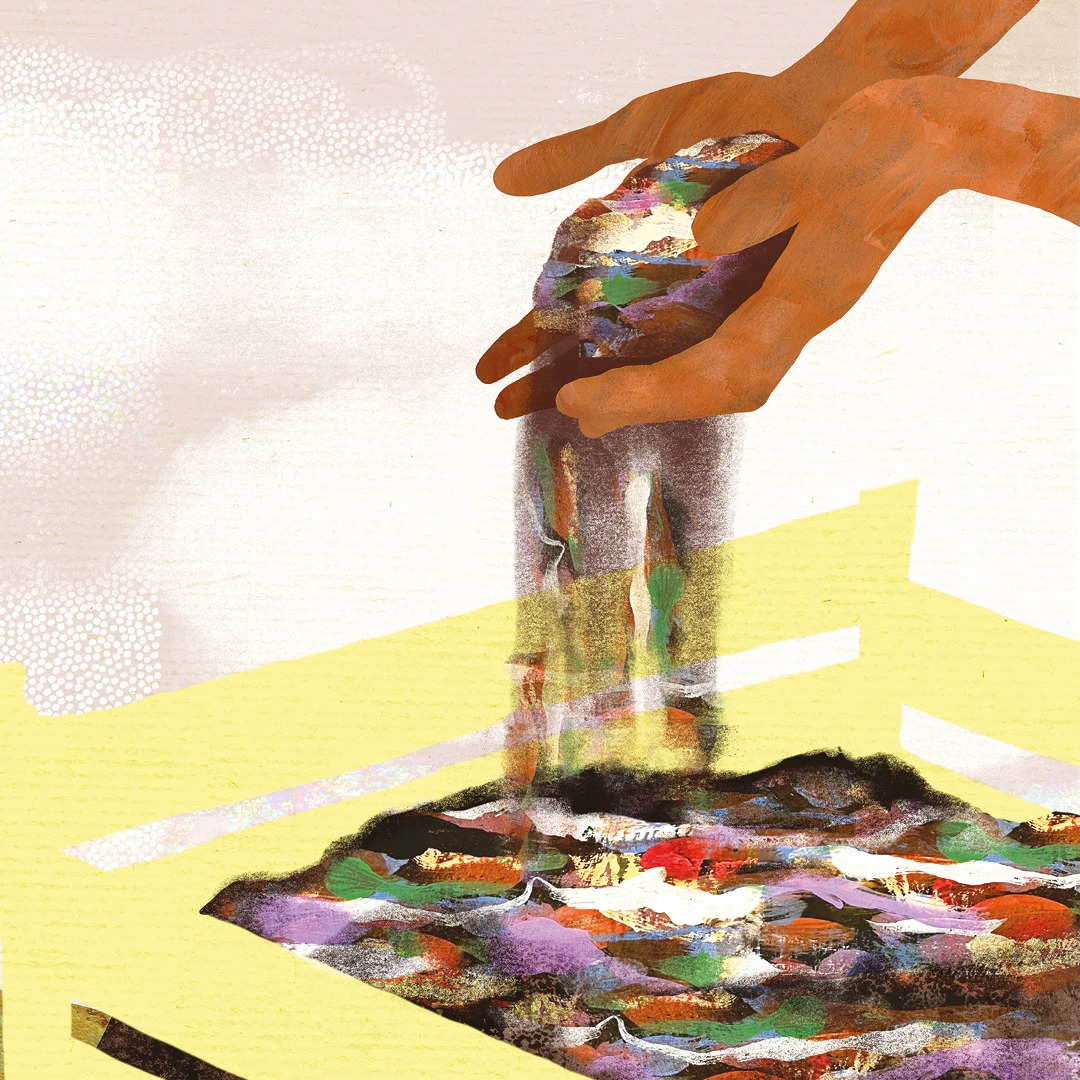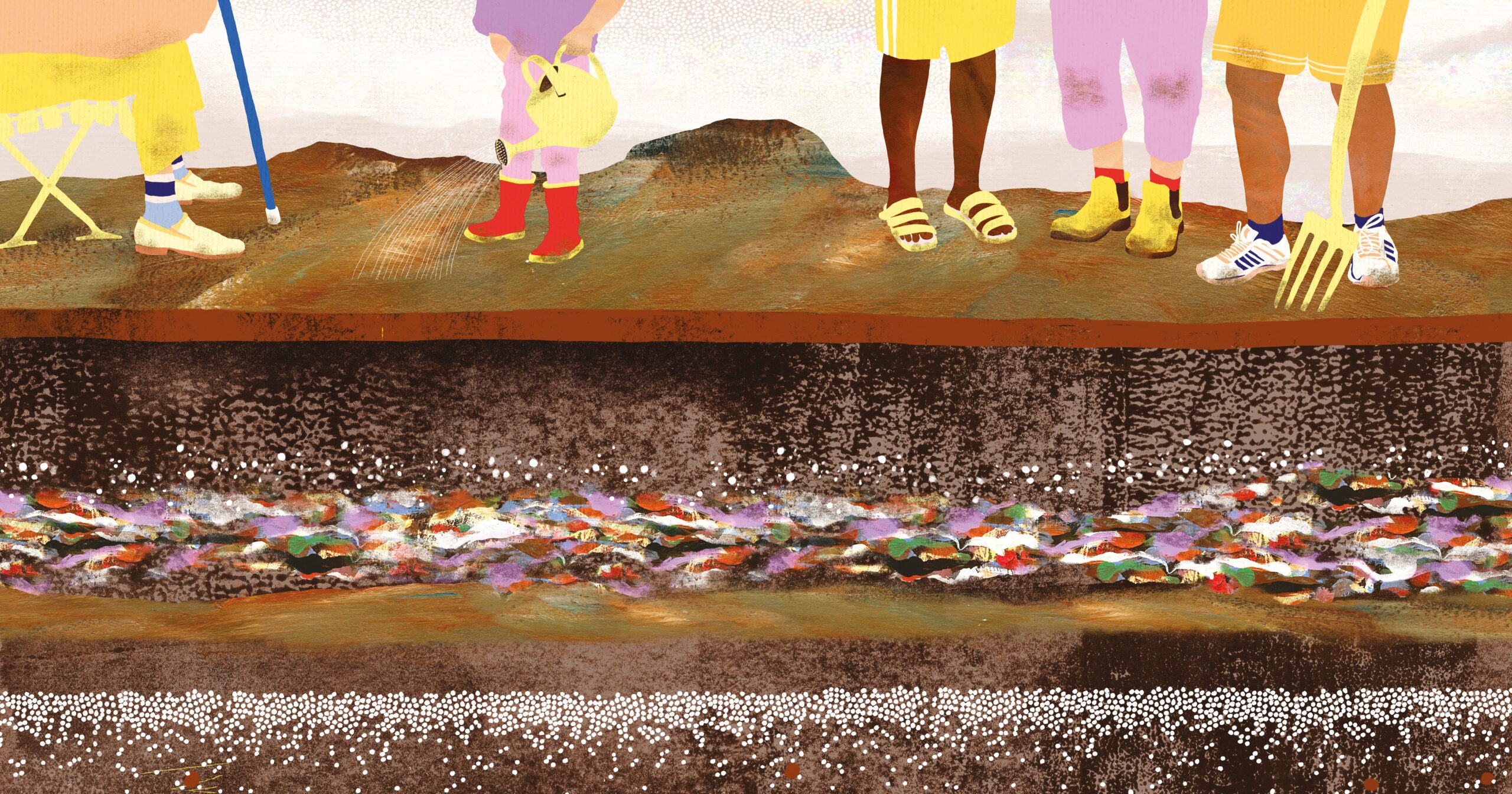All over the world, community composting is thriving – from collection of food scraps among neighbours to larger, more organised schemes in allotments, community gardens and schools. For growers, it can provide a rich source of fertiliser that may be better quality than shop-bought. But even if you’re not a gardener, you can still participate through the decision to share your kitchen waste instead of putting it in the bin.
It starts with community
From the bottom up, everything about the act of composting is based on bringing different elements together to create a resource that’s greater than its individual parts. Ernie Harbott, from Singleton, New South Wales, Australia, runs her own business called Compost Culture, supporting individuals, organisations and businesses to create compost systems, and is a committee member of the Local Community Compost Alliance Australia (LOCCAL). She explains that compost is made up of ‘a community of tiny microbes, little bugs, worms and even small mammals like mice’, and some of the bacteria in the compost is the same as in people’s healthy gut microbiomes. The very existence of compost is an act of community, and human communities are an important part of that cycle.
Clytie Binder, from Brisbane, is president of LOCCAL, which became a charity in 2024. She explains that composting isn’t just about reducing waste – it’s about nurturing thriving, connected communities. ‘Local composting projects spark joy, build neighbourly bonds and reconnect people with the natural rhythms of life, death and regeneration,’ she says.
How does community composting work?
Master composter, certified soil food web microscopist and self-taught soil ecologist, Ernie, who has a PhD in biogeochemistry (the study of interactions between organisms and their environment, or biosphere and geosphere), started community composting by inviting her neighbours to leave their food scraps in buckets on her doorstep to add to her own compost pile. ‘If you’re a gardener, you always need more compost,’ she laughs.
Community composting can happen on any scale, and if you’re contributing waste to another person’s compost heap, then you are part of that cycle. On a larger scale, allotments, businesses, community gardens and schools can all design composting systems and invite others to contribute. Ernie says she knows of allotments that benefit from composting coffee grounds from local cafes. People volunteer to tend the compost, turning it when needed and ensuring there’s the right balance of brown and green matter, or maintaining different bins for different types of waste or stages of the composting cycle.
There are regional and national organisations in various countries that support community composting initiatives. In Australia, LOCCAL was founded with the aim of supporting and connecting individuals and organisations involved in community composting, and currently has over 40 members across the country, including gardens, schools, community centres, clubs, apartment blocks, churches, farms and parks. The organisation has also formed international connections with initiatives in the UK, New Zealand, the US and even a refugee settlement in Uganda. ‘Our website has a What’s On guide for community compost-related events, a blog and this spring we started publishing a monthly newsletter,’ says Clytie.
For larger projects, it can also be worth taking advice from your local authority or environmental health office about regulations concerning green and brown waste in your area.
What are the benefits?
Besides bringing people together, community composting closes the loop between food production and food waste and keeps resources local. Diana McIntyre is community composting co-ordinator for the Closing Loops project, which is part of FoodFutures in North Lancashire, England, a Sustainable Food Place. Diana explains that it’s about ‘connectivity’ and is also great for climate action, because composting kitchen scraps reduces food miles and the need for council-run waste disposal.
‘If you can keep kitchen waste local, you can produce something really valuable that can then be used to grow food locally,’ she says. Composting becomes a practice – Diana explains that some residents living near one of the Closing Loops compost schemes describe taking their contributions out to the community compost bins as ‘taking the kitchen scraps out for a walk’. She adds: ‘It’s about fostering that sense that “this is ours” and helps to create resilience within communities.’
Ernie agrees that composting gives you a great opportunity to take small but positive action. ‘A lot of people suffer with eco-anxiety, but the problems can seem too big or too hard to tackle,’ she explains. ‘Composting is an empowering antidote, because instead of sending your food scraps to the local council incinerator, you can keep them within your community and feel good that they are being used for growth.’
Meanwhile, Clytie points out: ‘Community composting allows people to develop a sense of agency, enabling them to manage their own resources and at the same time support environmental renewal and food security.’ She adds it can create ‘meaningful’ volunteer and job opportunities. ‘Composting is a healthy, outdoor, low-cost, fossil-free practice that unites people across all walks of life and builds deep connections with the seen and unseen forces of nature,’ she says.
Composting in action
Some of the most successful grass-roots compost schemes work on many different levels. The Closing Loops project has a number of demonstration sites in North Lancashire, including an initiative at Scotch Quarry Urban Park in Lancaster, where raised beds enable local people to grow food. The community compost project provides compost for these beds – as well as take-home compost for those involved in the scheme.
‘There are rows of terraced houses nearby with backyards rather than gardens,’ says Diana. ‘We have about 35 households bringing their kitchen scraps out to the compost bins.’ The bins have combination locks to stop the dumping of unwanted waste and each member of the scheme has the code. ‘We have volunteers who stir the compost every week and check to see if we need extra cardboard,’ says Diana. ‘There’s even a WhatsApp group so they can ask people to bring egg boxes if needed.’
When the first bin matured, everyone involved was invited to bring a bucket, bag or wheelbarrow and take some compost, as well as enjoying tea and cake with their neighbours.
How can I get involved?
In most communities there’s no shortage of materials. If you want to start your own scheme you can reach out to neighbours, local allotments, schools or gardening clubs for advice. Ernie runs monthly Coffee & Compost meetings in Singleton, where gardeners get together and exchange jars of their own home compost. ‘Swapping compost inoculates each other’s compost piles with a wider variety of microbes,’ she says.
You don’t have to be green-fingered to support a community compost scheme. It can be as simple as calling in to your local allotment association or school garden and asking if they accept donations of household food waste, or offering scraps to a neighbour who’s a keen gardener. Clytie says: ‘It doesn’t require fancy equipment – just a willingness to experiment. Sharing composting knowledge is easy and enjoyable, and once people understand the basics, they often find composting becomes slightly addictive and they’re excited to share with others or reach out to their neighbours to take their scraps!’
Finally, don’t forget that composting can be an act of mindfulness, as good-quality compost can take time and patience. ‘Composting is a small but radical act that anyone can do,’ says Ernie. ‘By keeping and using your food scraps, you have the opportunity to nurture yourself, your garden, your neighbours and your community.’
Getting started
Thinking of setting up your own community compost scheme? Here are some tips
Make connections
Research online to find existing community composting networks, sustainable food initiatives or organic gardening groups in your area.
Use your eyes!
What exists locally? Do you have allotments, a city farm, community gardens or parks nearby? Is there a neighbourhood noticeboard or messaging group you could use?
Think about structure
How many bins do you need and how will you secure them? A lock can prevent unwanted items being dumped, and measures can be taken to guard against vermin.
Set clear rules
Be specific on what kind of waste you want your members to add to the compost. Will it be limited to raw kitchen scraps? Will you accept cardboard waste or grass cuttings?
Create your community
An online messaging group or group-access document can help you communicate information such as particular materials needed, or when the compost is ready for harvesting.
Assign tasks
Volunteers might take on the role of turning the compost regularly or deciding when you need a little more moisture, or brown or green waste.
Have fun!
Enjoy the thriving community you’re creating. Invite people to bring a bucket when the compost is ready, swap gardening tips and cuttings or stop for tea and cake. Make the compost feel like ‘ours’.
For FoodFutures visit foodfutures.org.uk/composting or follow @foodfutures.northlancashire. LOCCAL can be found at loccal.org or @loccal_aus. Search Compost Culture on Facebook


